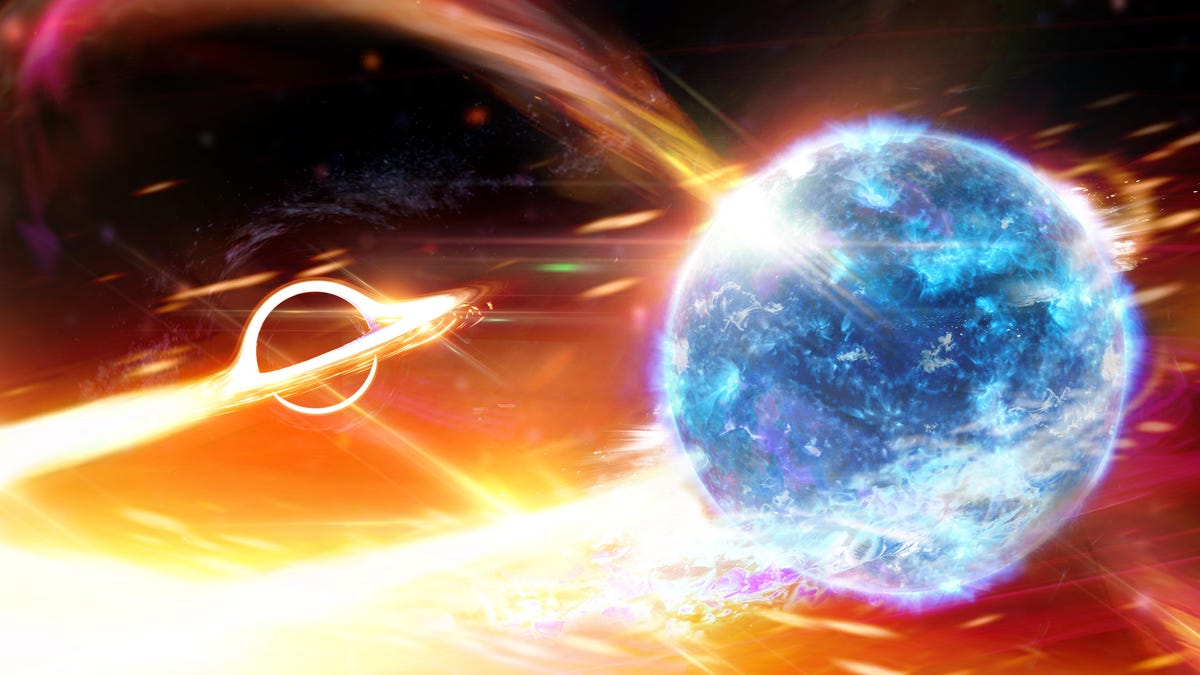Ripples in space-time suggest a black hole swallowed a neutron star
If confirmed, it would be the first neutron star-black hole merger ever detected.

Black hole, meet neutron star. Neutron star, this is black hole. Play nice.
Astronomers watching the cosmos for faint ripples in space-time may have detected a black hole swallowing up a neutron star for the very first time. Gravitational wave observatories in the US and Europe were switched back on after upgrades in April to hunt for these extreme cosmic events, and since then have detected 23 potential cosmic wobbles. The latest is perhaps the most exciting yet -- and it's also potentially the most puzzling.
The event, designated S190814bv, was detected on Aug. 14 by the finely-tuned lasers of the twin LIGO detectors in the US and the Virgo detector in Italy. The facilities picked up ripples in the fabric of the universe and have, tentatively, suggested they resulted from a collision between a black hole and a small, dense star known as a "neutron star".
The facilities have seen potential black hole-neutron star collisions in the past, but none have been adequately verified. Since switching back on in April, only three candidates for this insane type of cosmic collision have been presented with varying levels of confidence. That's because the detectors are so fine-tuned they sometimes flag noise as real events.
For S190814bv, the chance the newly-detected signal is just noise is 1 in 10 septillion years.
That would even put Han Solo off believing S190814bv is anything but a neutron star-black hole merger, but the researchers are still urging caution. It could be, they say, two merging black holes.
Taking 3 and 5🌞masses as our "cut-off" labels for #NeutronStars or #BlackHoles is a useful rule-of-thumb but it could be wrong - or at least not the full picture. So #S190814bv *could* still be 2 merging #BlackHoles... Lots more careful analysis may tell us the answer!... 3/5 pic.twitter.com/0RSc5jk0xc
— LIGO (@LIGO) August 17, 2019
That throws up an exciting possibility that one of the black holes would be lighter than any black hole we've ever seen before. We can't lose!
If the event is confirmed as a neutron star-black hole merger, it would complete LIGO and Virgo's trifecta of cosmic detections. The facilities have seen black holes merge with black holes and neutron stars merge with neutron stars, but they've never seen the two obliterate one another.
The next step is to focus telescopes on the small section of the sky S190814bv came from. It's relatively close, by cosmic standards, at just 900 million light-years away. What will we see?
"We will either see a neutron star being ripped apart by a black hole, or getting swallowed whole like Pac-Man swallowing a ghost," says Simon Stevenson, an astronomer with Swinburne University of Technology in Australia. "Either way, we are in for a show!"

